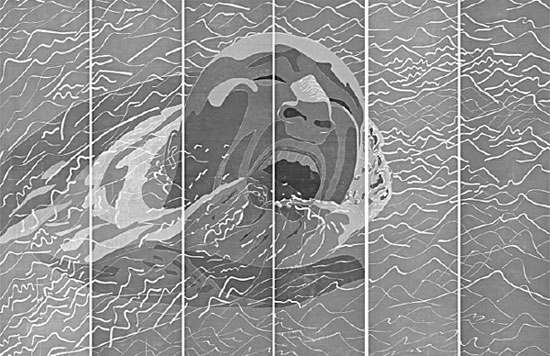

A set of six woodblock prints, 1999, by Fang Lijun.
"Xu Bing, for instance, applied a lot of carving techniques in many of his late works. But he has never restricted himself to the form of engraving. Instead, he demonstrates flexibility in incorporating multiple media that attests to the value of handicrafts and what it means to be human in his works."
The Liberated Instrument section will examine how academic training in engraving influences an artist's thoughts.
"Engraving is not used for political propaganda anymore, nor has it stayed just at the academic level. Instead it has become a liberated form that allows artists to explore all possibilities," says Kang Jianfei, secretary-general of the engraving committee under the China Artists Association. Kang is curating the section.
It will display, for example, Sun Xun's animation works.
A year after he graduated from the engraving department of the China Academy of Art in 2005, Sun, 34, established his own animation studio in Beijing. His works, usually in black and white, discuss the construction and narration of history. The animation works that will be on show were produced through a series of engravings instead of drawings.
Many artists seek inspiration from engravings or related topics. The connection can be seen in physical forms, too, and, more importantly, in the process of conceiving artwork.
The Logic Behind section displays more experimental, mixed media efforts to discuss how engravings are reflective of social transformation.
Sheng Wei, deputy editor in chief of Beijing-based Fine Arts magazine and curator of the section, believes engraving was "new media" in the era of classical arts.
"It became a public medium because a great number of messages could be reproduced and circulated. It symbolized the efficiency of communication and indicated social changes," he says.
The section exhibits pieces that embrace these features. The paper-cuttings, for example, served as message carriers during the agricultural times.
The fourth section will be a solo show of Tan Ping, deputy-director of the Beijing-based Chinese National Academy of Arts. The exhibition will reflect upon the 54-year-old's signature creations in the past 30 years. Curator He Guiyan from the Sichuan Fine Art Institute says the show is a case study on an engraving artist's interactions with time.
The exhibition will run until March 2015.
Copyright ©1999-2018
Chinanews.com. All rights reserved.
Reproduction in whole or in part without permission is prohibited.